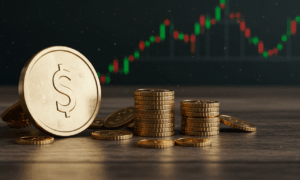What Are Guaranteed Investment Products? Your Guide to Investing with Confidence
Are you navigating the world of investing but feel held back by the fear of losing your hard-earned money? In a landscape filled with market volatility and complex financial instruments, the desire for security is completely understandable. This is precisely where guaranteed investment products come into play. They are designed for investors who prioritize capital preservation over high-risk, high-reward opportunities. If you’re looking for a way to grow your wealth steadily without the sleepless nights, this article will provide you with a clear and comprehensive overview of these secure financial tools.
We will explore what guaranteed investment products are, break down the most common types available, weigh their advantages and disadvantages, and help you determine if they are the right fit for your personal financial strategy. By the end, you will have the knowledge to make more informed decisions that align with your risk tolerance and long-term goals.
Defining Guaranteed Investment Products
At its core, a guaranteed investment product is a financial instrument that offers a promise to return your initial investment amount, known as the principal, in full at the end of a specified term. In many cases, these products also offer a pre-determined or minimum rate of return. The term guaranteed refers to this protection of your capital. Essentially, you are lending your money to a highly stable institution—such as a bank, a credit union, an insurance company, or the government—and in return, they agree to pay you back with interest, all while ensuring your original sum remains intact.
The security of this guarantee is tied directly to the financial strength of the issuing institution. For example, products from major banks are often protected by government-backed deposit insurance schemes, adding an extra layer of security. This makes them one of the safest options available in the world of finance, appealing to those who cannot afford to risk their principal investment.
Exploring the Common Types of Guaranteed Products
While the core principle is the same, guaranteed investment products come in several forms. Understanding the differences is key to choosing the one that best suits your needs. Here are some of the most prevalent types:
- Guaranteed Investment Certificates (GICs) or Certificates of Deposit (CDs): These are among the most popular and straightforward options. When you purchase a GIC or CD from a bank or credit union, you agree to lock in your funds for a fixed period, ranging from a few months to several years. In exchange, the financial institution pays you a fixed interest rate, which is typically higher than a standard savings account. Your principal and the promised interest are guaranteed.
- Government Bonds: When you buy a government bond, you are essentially lending money to a federal, state, or municipal government. These are considered one of the safest investments in the world because they are backed by the full faith and credit of the government issuer, which has the power to tax and print money. They pay periodic interest (coupons) and return the principal at maturity.
- Fixed Annuities: These are insurance products that can provide a stable element to your retirement planning. You make a payment (or series of payments) to an insurance company, and in return, they guarantee a fixed interest rate on your investment for a set period. At the end of the term, you can often choose to receive your funds in a lump sum or as a stream of regular income payments.
- Market-Linked Guaranteed Investments: Also known as principal-protected notes, these are more complex hybrid products. They guarantee your principal but link your potential returns to the performance of an underlying asset, such as a stock market index. If the index performs well, you earn a return (often up to a certain cap), but if it performs poorly, you still get your initial investment back. They offer a taste of market potential without the risk to your principal.

The Pros and Cons: A Balanced Perspective
Like any financial tool, guaranteed investment products have both compelling benefits and notable drawbacks. A clear-eyed view of both sides is crucial before you commit your funds.
The Advantages
The primary appeal of these products lies in their security and predictability. The main benefits include:
- Capital Preservation: This is the number one reason investors choose them. The promise that you will not lose your initial investment provides immense peace of mind, especially in turbulent economic times.
- Predictable Returns: With most of these products, you know exactly how much interest you will earn and when you will receive it. This predictability makes financial planning for specific goals, like a down payment or retirement income, much easier.
- Simplicity and Accessibility: Products like GICs and government bonds are generally easy to understand and purchase through most banks and brokerage firms. They do not require the extensive research and constant monitoring that stock market investing does.
The Disadvantages
The safety offered by these products comes at a cost, which you must be willing to accept.
- Lower Potential Returns: This is the biggest trade-off. In exchange for safety, you sacrifice the potential for higher growth that comes with more volatile assets like stocks. Over the long term, the returns from guaranteed products are unlikely to match those of the broader stock market.
- Inflation Risk: A significant, often overlooked danger is that the fixed return on your investment may not outpace the rate of inflation. If your investment earns 2% and inflation is at 3%, your money is actually losing purchasing power over time.
- Limited Liquidity: Your money is typically locked in for the duration of the term. If you need to access your funds early, you will likely face a penalty, which could erode your interest earnings or even a portion of your principal.
- Opportunity Cost: By locking your money into a low-yield safe investment, you are forgoing the opportunity to invest that money in assets that could generate significantly higher returns.
Are Guaranteed Investment Products Right for You?
These products are not a one-size-fits-all solution, but they are an excellent fit for certain investor profiles and financial situations. You should strongly consider them if you identify with one of the following categories:
- The Risk-Averse Investor: If the thought of a market downturn makes you anxious and your primary goal is to protect your money, these products are tailor-made for you.
- Retirees and Pre-Retirees: For those who are in or approaching retirement, preserving capital is often more important than maximizing growth. Guaranteed products can provide a stable income stream and protect a nest egg.
- Short-Term Savers: If you are saving for a major purchase within the next one to five years—such as a house, a car, or a wedding—you cannot afford to risk that money in the stock market. A guaranteed product ensures the funds will be there when you need them.
- Portfolio Diversifiers: Even aggressive investors can benefit from allocating a portion of their portfolio to these safe assets. They provide a stable anchor that can cushion the impact of a decline in the riskier parts of your portfolio. This is a fundamental concept in building a balanced investment strategy.
Conclusion
Guaranteed investment products serve a vital function in the financial world, offering a safe harbor for capital in an ocean of market uncertainty. They deliver on their core promise: the protection of your principal, combined with modest, predictable returns. While they may not generate spectacular wealth, they provide the invaluable gift of security and peace of mind.
Their suitability depends entirely on your individual circumstances, including your risk tolerance, time horizon, and financial goals. For those prioritizing capital preservation—such as retirees, cautious investors, or anyone saving for a short-term goal—they are an indispensable tool. For others, they can play a key role in a diversified portfolio, balancing out higher-risk assets. By understanding how they work, you can confidently decide if these secure foundations have a place in your financial future.
Frequently Asked Questions (FAQ)
Are guaranteed investment products completely risk-free?
While they are extremely low-risk, no investment is entirely free of risk. The main risk associated with these products is inflation risk, where the return you earn is lower than the rate of inflation, causing a loss of purchasing power. There is also a minuscule credit risk—the possibility that the issuing institution could fail. However, this is largely mitigated by government-backed deposit insurance programs for banks and the high credit quality of government issuers.
Can I lose money with a guaranteed investment product?
Under normal circumstances, where you hold the product to its maturity date, you are guaranteed not to lose your principal investment. However, you could effectively lose money in two ways: first, if you need to withdraw your funds before the term ends, you may be subject to early withdrawal penalties that could reduce your returns or even dip into your principal. Second, as mentioned above, your money’s real value can decrease if your return does not keep up with inflation.
How do these products fit into a broader investment portfolio?
Guaranteed investment products typically form the foundation of a well-diversified portfolio. Financial advisors often recommend them as the “safe” portion of an asset allocation strategy. They provide stability and a predictable return that helps offset the volatility of riskier assets like stocks or real estate. For example, in a portfolio split 60/40 between stocks and bonds, the bonds and other guaranteed products represent the 40% designed to preserve capital and provide steady income, regardless of what the stock market is doing.





